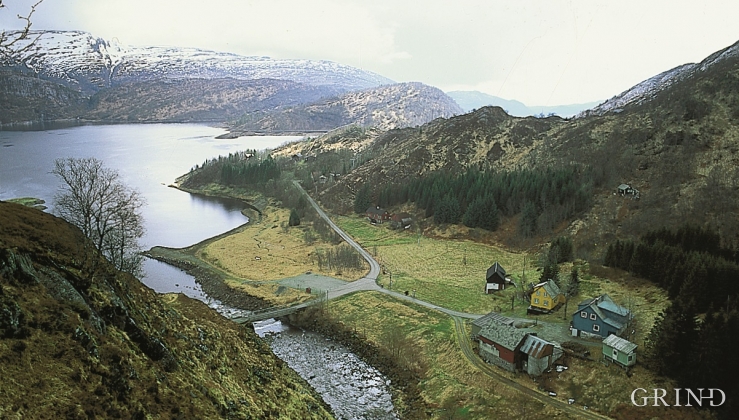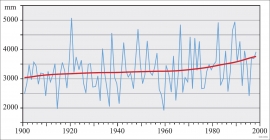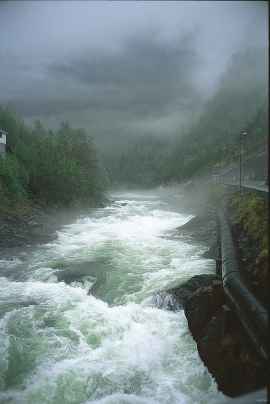Published: 28.10.2004 | Author: Endre Skaar
From Kvitingen nature preserve. The weather station is located beside the road between the farm and the road crossing. (Svein Nord)
When the Bergen Electric Company set up the weather station on Kvitingen in 1900, it was with the intention of building out the Samnanger water system in order to supply Bergen with electrical power. The people in that little village made the station welcome, but they did not realize then that it would give them both work and records in the future. The biggest rainfall that is recorded is from 1921; it was 5087 mm. Rainfall reached nearly 5000 mm both in 1967, 1983, 1989 and 1990. In the year 1989, the record was set for monthly rainfall in January, with an impressive 1076 mm. A monthly rainfall of just over 1000 mm occurred also in December of 1975 and in October of 1983. Only in two years was the annual rainfall less than 2000 mm: in 1915 (1984 mm) and in 1960 (1926 mm).
The amount of rainfall varies a lot from year to year, but if one considers a period of many years, there has been an increase. On average, there has been an increase in rainfall during the last century, from ca. 3000 mm to 3800 mm, about 25%. The increase has been especially noticeable the last 30 years.
The average increase in annual rainfall reflects that there have been both more days with rainfall and more days with big amounts of rain. The reason for this is that more weather comes in from the west to western Norway in past years. Comparable, and even a bigger percent-wise increase in rainfall, occurred in the inner districts of the county, for example, in Hardanger and Voss.
Climatic change
During the past century there has been an increase in rainfall in western Norway. The amount of rainfall in winter especially has increased. Most people wonder what the reason might be, and if the increase is going to continue into the future?
Most of the rainfall comes from the west during the winter half of the year. Between a low pressure area over Iceland and a high pressure area near the Azores, there is just a broad band of strong wind that presses the moist air in over Northwest Europe. These air gives milder winters and lots of rain. We know that this weather pattern has become more common: compared with earlier, both the low pressures over Iceland and the high pressures over the Azores have become more stable. This is part of a larger change that is happening over most of the northern hemisphere.
The reason for the climatic change is much debated. The United Nations' Climate Panel (IPCC) thinks that it is largely a result of human emissions to the atmosphere. This gives a temperature increase on the one hand, which in turn causes more rainfall. It is expected that there will be larger variations from year to year, and often quite heavy rainfall. With the predictions we have for future emissions to the atmosphere, we should probably look forward to even milder and wetter winters.





